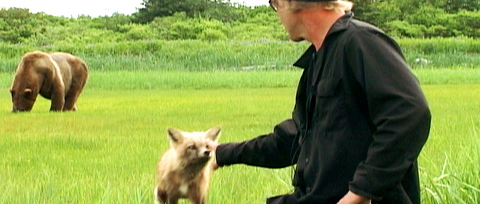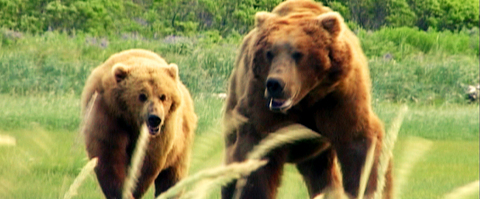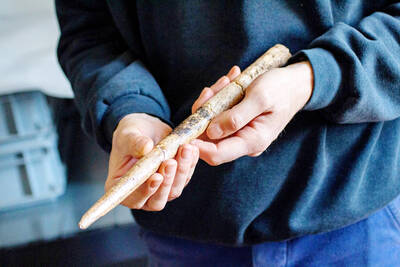One rainy afternoon in the Alaskan wilderness two years ago, a self-made man named Timothy Treadwell was mauled and eaten by a grizzly bear. It may be that the animal, a scrawny male about 28 years old and 454kg, was trying to fatten up in preparation for its winter's sleep. As it happens, Treadwell, who achieved minor celebrity as an expert on grizzlies, publishing a book on the bears and jousting with David Letterman on late-night television, had pitched his tent in a feeding ground. The call of the wild was as irresis-tible to Treadwell as his flesh proved to be to that bear.
The strange story of Timothy Treadwell, a Long Island native who came to see himself as some kind of ursine Dr. Dolittle, only to die at 46 from a bear attack, is the subject of Grizzly Man, the latest documentary from Werner Herzog. As fans of the German New Wave know, the director has a fondness for stories about men who journey into the heart of darkness, both without and within — men like the deranged 16th-century explorer in Aguirre, the Wrath of God, who searches for El Dorado in the Amazon, and the early-20th-century esthete in Fitzcarraldo who hauls a steamboat up a mountain to bring Caruso to the Peruvian jungle. Treadwell's journey was no less bold or reckless than these earlier Herzogian tales and certainly no less enthralling.
Herzog has been making documentaries for more than three decades, about as long as he has been directing fiction films, but he is not part of any nonfiction tradition. In a statement on his Web site, wernerherzog.com, he declares: "By dint of declaration the so-called cinema verite is devoid of verite. It reaches a merely superficial truth, the truth of accountants." This is a rather crude attempt to separate himself from the nonfiction crowd, but Herzog is also no ordinary filmmaker. It is the rare documentary like Grizzly Man, which has beauty and passion often lacking in any type of film, that makes you want to grab its maker and head off to the nearest bar to discuss man's domination of nature and how Disney's cute critters reflect our profound alienation from the natural order.

PHOTOS COURTESY OF JOINT ENTERTAINMENT
Beauty enters first in Grizzly Man, which opens with two bears grazing on a spectacular stretch of green in the Katmai National Park and Preserve, a nearly 2-million hectare swath on the Alaska Peninsula. Dressed in black, his pageboy stirring in the wind, Treadwell walks into the frame and introduces the grizzlies as Ed and Rowdy. "They're challenging everything, including me," he says as the bears munch away. "If I show weakness, if I retreat, I may be hurt, I may be killed. I must hold my own if I am going to stay within this land. For once there is weakness, they will exploit it, they will take me out, they will decapitate me, they will chop me into bits and pieces. I'm dead. But so far, I persevere, persevere."
It is a typical Treadwell recitation — sincere, grandiose and intensely worrisome — a bit of bravura that ends with the self-designated "kind warrior" blowing a kiss and signing off like Kojak: "Love you, Rowdy." Even if you don't know that Treadwell was killed along with his girlfriend, a physician's assistant named Amie Huguenard, his familiarity with, and proximity to, the bears bodes badly, for him and for them. There is something surreal (at least to a committed urbanite) about anyone who would talk to these animals, especially a guy whose blond, bland good looks made him seem like an aging surfer, a kind of Spicoli of the backwoods. But as Herzog points out in his online manifesto, "facts sometimes have a strange and bizarre power that makes their inherent truth seem unbelievable."
Despite some early bumps, Treadwell started off as an average sort. After an injury put an end to an athletic scholarship, he moved to (where else?) Southern California. There he did the usual bumming around, but his life soured and, according to his book, Among Grizzlies, written with Jewel Palovak, he suffered a near-fatal drug overdose. Scared straight, he gradually reinvented himself, and by the early 1990's was summering in Katmai, home to about 2,000 grizzlies. Herzog lays out this history in voice-over, illustrating Treadwell's ups and downs through the spectacular videos the amateur naturalist shot and interviews with the dead man's family and friends. The filmmaker also taps the medical examiner who performed the autopsies on Treadwell and Huguenard, Franc Fallico, a character around whom an entire reality show could be built.

Fallico pops up a couple of times in Grizzly Man, but the most potent use of his testimony occurs when he expounds at length in an autopsy room, a scene that illustrates Herzog's sense of drama beautifully. Sporting a blue smock and a fixed gaze, Fallico recounts his version of the attack, a description based on his examination of the bodies and the six-minute audio record found on one of Treadwell's video cameras. (The lens cap was on the camera.) The account is graphic, gruesome and thoroughly riveting, partly because morbid tales always tug at the imagination, but also because Fallico turns out to be an incredible storyteller. For Herzog, it's clear that the truth of this story isn't located just in the facts that the doctor strings together with florid gestures and pregnant pauses, but in a performance that is as artful as it is true.
Treadwell's adventures among his beloved grizzlies were also a kind of performance, built on lies and truth and played out on the stage of celebrity. Even though his choices were dangerous and finally fatal, he traveled a familiar American path shaped by boundless optimism and an almost religious belief in the self. He lived among grizzlies because he believed that he could. Given this, the cheap shots that followed his death, including the appalling snarkiness that crept into newspaper headlines ("Grizzly bear that killed pair attacked at lunchtime"), are revelatory. For some, Treadwell's death confirmed that animal activists and environmentalists are dangerous wackos; for others, though, his unhappy end may have suggested something equally disturbing: sometimes a smile and American goodwill aren't enough.
Throughout Grizzly Man, men and women pay testament to Treadwell's niceness and naivete. Some are kind; others less so. Each testifier seems to capture some authentic quality of Treadwell, who from the evidence of his videos and Herzog's sympathetic inquiry, seemed equally nice and naive, brave and foolish. At some point that foolishness mushroomed into a welter of delusions about his power to survive the wilderness in which he so recklessly tried to find himself. His death, as inevitable as it was preventable, could mean that he may have been more lost than found. Herzog remains generous to a fault on this particular point, perhaps because he recognizes that for someone like Treadwell, there is nothing more terrifying than being ordinary, even the claws of a grizzly.

June 2 to June 8 Taiwan’s woodcutters believe that if they see even one speck of red in their cooked rice, no matter how small, an accident is going to happen. Peng Chin-tian (彭錦田) swears that this has proven to be true at every stop during his decades-long career in the logging industry. Along with mining, timber harvesting was once considered the most dangerous profession in Taiwan. Not only were mishaps common during all stages of processing, it was difficult to transport the injured to get medical treatment. Many died during the arduous journey. Peng recounts some of his accidents in

“Why does Taiwan identity decline?”a group of researchers lead by University of Nevada political scientist Austin Wang (王宏恩) asked in a recent paper. After all, it is not difficult to explain the rise in Taiwanese identity after the early 1990s. But no model predicted its decline during the 2016-2018 period, they say. After testing various alternative explanations, Wang et al argue that the fall-off in Taiwanese identity during that period is related to voter hedging based on the performance of the Democratic Progressive Party (DPP). Since the DPP is perceived as the guardian of Taiwan identity, when it performs well,

A short walk beneath the dense Amazon canopy, the forest abruptly opens up. Fallen logs are rotting, the trees grow sparser and the temperature rises in places sunlight hits the ground. This is what 24 years of severe drought looks like in the world’s largest rainforest. But this patch of degraded forest, about the size of a soccer field, is a scientific experiment. Launched in 2000 by Brazilian and British scientists, Esecaflor — short for “Forest Drought Study Project” in Portuguese — set out to simulate a future in which the changing climate could deplete the Amazon of rainfall. It is

Artifacts found at archeological sites in France and Spain along the Bay of Biscay shoreline show that humans have been crafting tools from whale bones since more than 20,000 years ago, illustrating anew the resourcefulness of prehistoric people. The tools, primarily hunting implements such as projectile points, were fashioned from the bones of at least five species of large whales, the researchers said. Bones from sperm whales were the most abundant, followed by fin whales, gray whales, right or bowhead whales — two species indistinguishable with the analytical method used in the study — and blue whales. With seafaring capabilities by humans